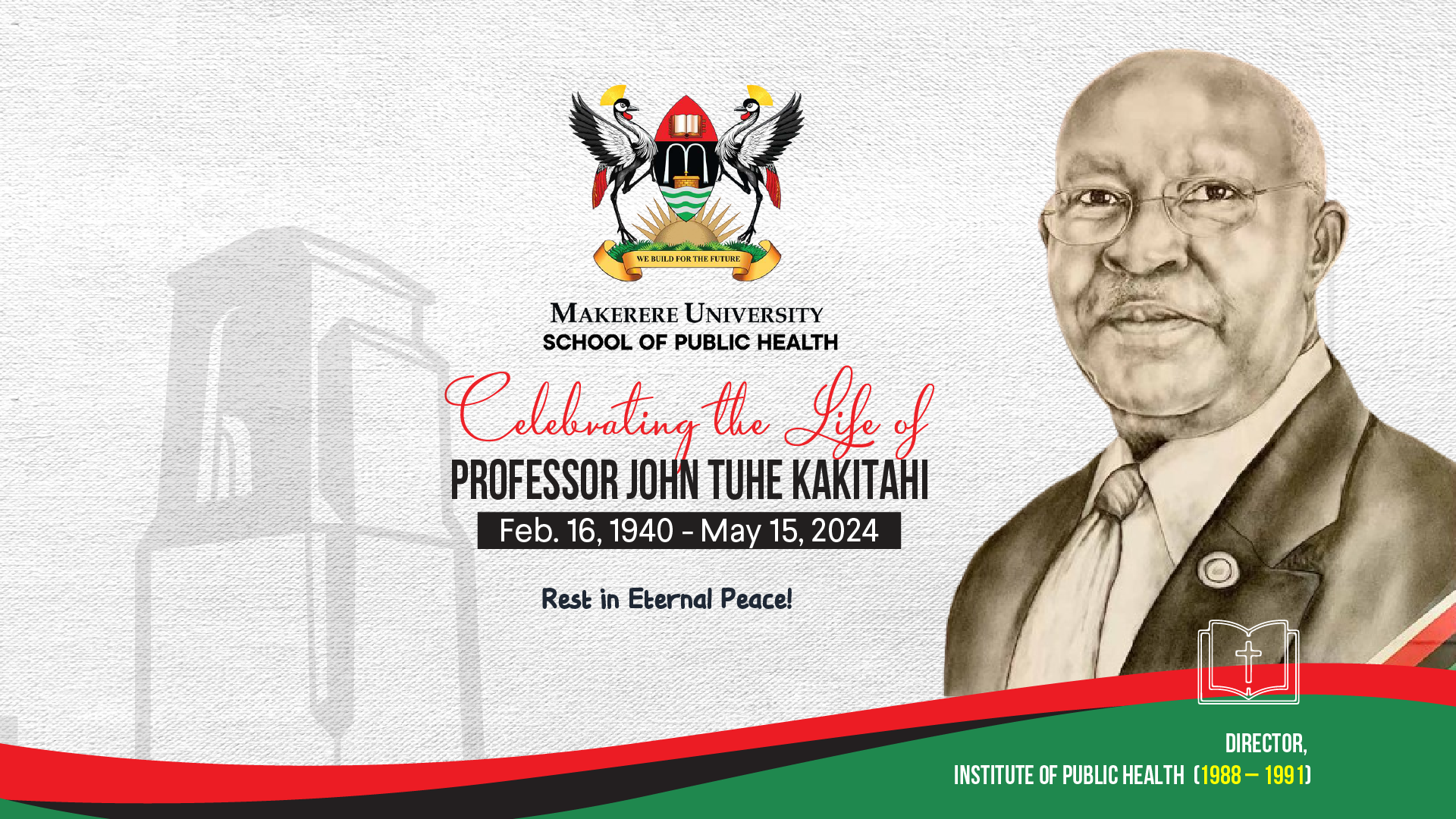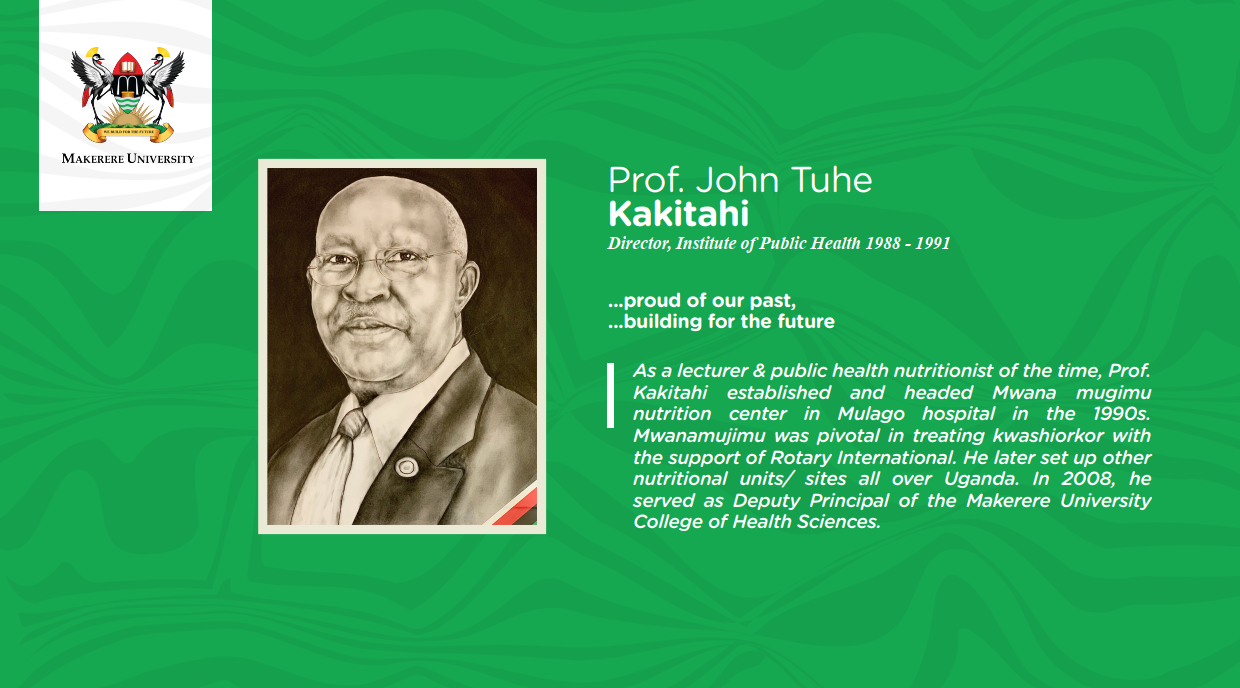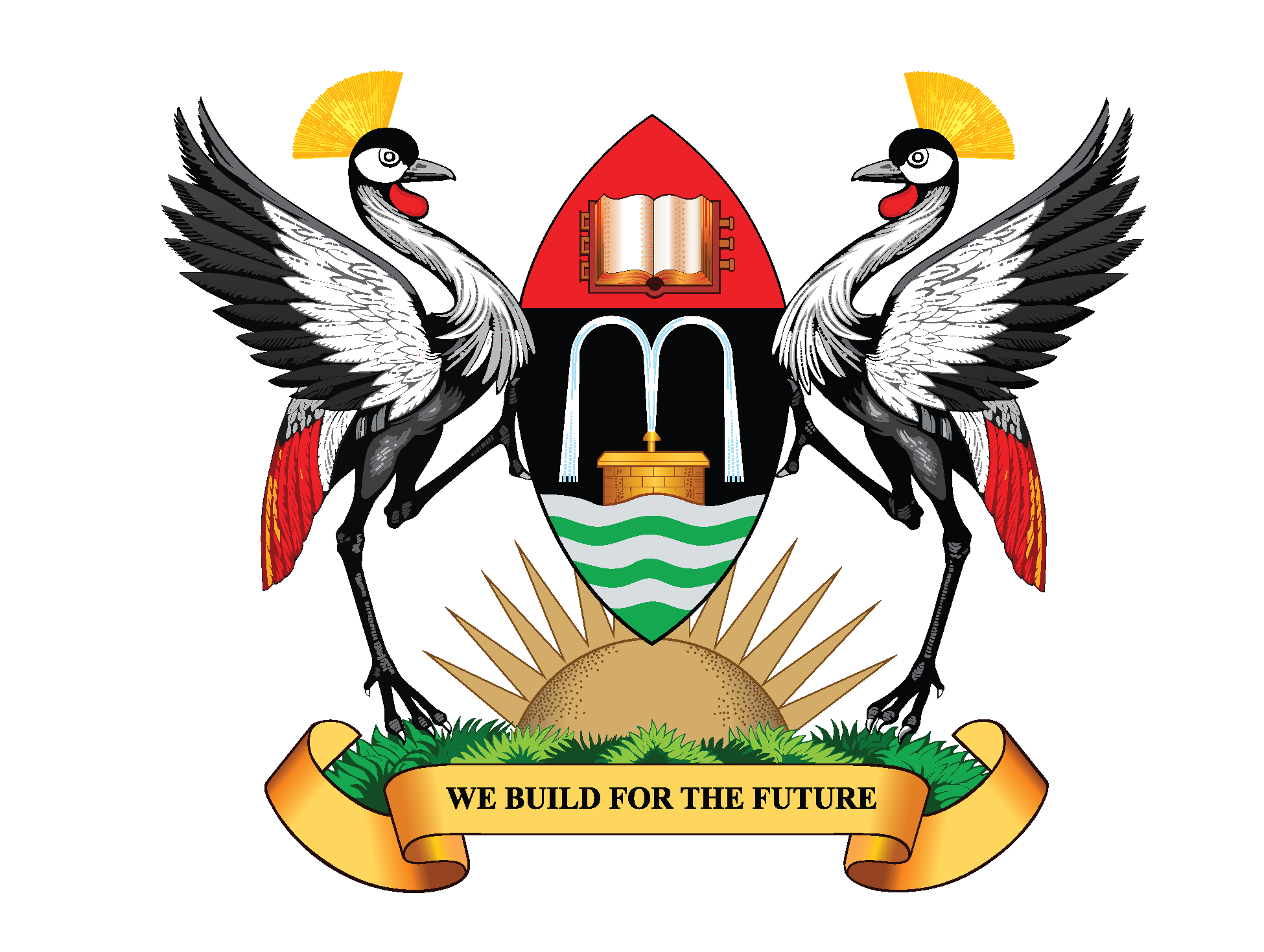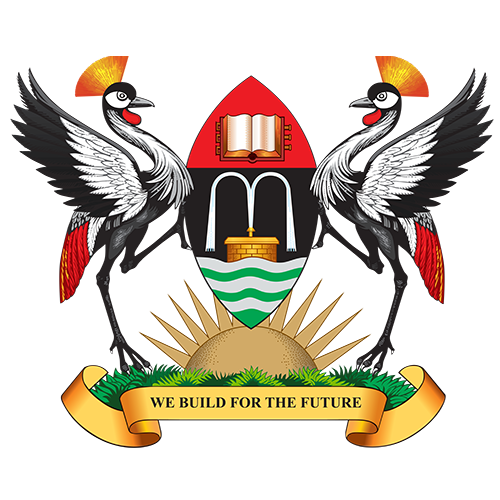
Professor John Tuhe Kakitahi, a luminary in the field of public health nutrition has left an indelible mark on the landscape of healthcare in Uganda and beyond. At the age of 84, Professor Kakitahi was called to heaven this morning at Mulago Hospital.
Today, we celebrate a man who from his early career years, demonstrated exceptional intellect, clinical acumen, passion and complete dedication to combating hunger, malnutrition and human suffering. Throughout his tenure at Institute of Public Health (IPH), Dr. Kakitahi's contributions were manifold. He in addition to teaching and mentorship conducted field investigations and community outreaches to improve human nutrition and maternal-child health. Kakitahi's contribution and influence in nutrition transcended borders, as he represented Uganda with distinction at various international forums.
As a lecturer and public health nutritionist, Prof. Kakitahi established and headed Mwana mugimu nutrition center in Mulago hospital in the 1990s. Mwanamujimu became pivotal in treating kwashiorkor aided by support from Rotary International. He later established additional nutritional units and sites throughout Uganda.
In 2008, he served as Deputy Principal of the Makerere University College of Health Sciences.

But Who was Kakitahi?
Prof. John Tuhe Kakitahi was born on February 16, 1940. His university appointment came in March 1973. Now, picture Dr. Kakitahi as a hardworking, intellectual house surgeon with clinical acumen who was a good clinician, pediatrician, researcher, and nutritionist. In the early years of his career at the Department of Preventive Medicine, he collaborated with individuals such as the late Prof. Suleiman Jabir Farsey and Professor Joseph Sekyala Winter Lutwama (RIP), who was the first African to hold the title of Head of the Department of Preventive Medicine. The individuals he collaborated with provided an accurate portrayal of his character.
From 1948 until 1958, Dr. Kakitahi studied primary education at Kigezi High School. He studied Secondary O'Level at Busoga College Mwiri from 1957 to 1961 and 'A' level at Kings College Budo from 1962 to 1963. In 1964, he attended Makerere University and earned an MBChB in 1970.
Kakitahi was Senior Casualty Officer in New Mulago Hospital's Casualty Department for 1.5 years before enrolling in IPH's Diploma Course in Public Health. He managed department operations and provided emergency patient treatment. The Senior House Officer position at Mulago Hospital was Dr. Kakitahi's first job after his internship. For 1.5 years, he oversaw casualty department patient care and administration. He also managed the Nurses Health Unit for a similar time, exhibiting his healthcare administration versatility and dedication.
Kakitahi also ran a Nutritional Rehabilitation Clinic at Kasangati Health Centre, providing critical services to the community. He also helped the Pediatrics Department in managing the Old Mulago Hospital's Nutrition Ward. He intensively treated acutely malnourished children, contributing significantly to their care and recovery.
In 1968-1969, he worked in the Lymphoma treatment center and Solid Tumor Centre during school breaks. He took part in research on chemotherapy treatment for cancer patients as well.
Using his medical background, he joined the Institute of Public Health (IPH) in 1972 and earned a Diploma in Public Health in 1973.
In 1973, he joined Makerere University Service as an IPH Lecturer. He passionately taught human nutrition to undergraduate and postgraduate students, particularly Diploma in Public Health students, as part of the Maternal Child Health and Nutrition teaching programme. His focus was on MCH field investigations, particularly the Ankole PPP.
On July 1, 1977, Dr. Kakitahi became a senior lecturer. Later, for 45 days, Dr. Kakitahi replaced Dr. Kakande as IPH director on June 22, 1987. He was sitting in for the then director, Professor Namboze, who was on a special assignment for the Health Policy Review Commission. On August 1, 1984, he was appointed as an Associate Professor at the Institute of Public Health. On September 18, 1989, Dr. Kakitahi assumed the position of Head of the Institute of Public Health for a two-year term.
Dr. Kakitahi's remarkable journey is interwoven with stories of dedication, expertise, and significant impact. As a young medical practitioner, he worked as a Medical Officer at Makerere Students Health Centre for several months in 1973, shortly after being hired as a Lecturer at IPH, where he laid the groundwork for the transformation of the then-Sickbay into the current University Hospital. Dr. Kakitahi pursued excellence by finishing his MSc in Nutrition at Cambridge on a WHO scholarship from 1974 to 1976. His abilities and commitment made him a well-known member of the Uganda Medical Association and the British Nutrition Society, both of which promote health locally and globally.
In 1977, he successfully represented Uganda at the 27th WHO Regional Committee for Africa in Brazzaville, Congo. This was the first of several significant appointments, including leading the Mwanamugimu Nutrition Unit in 1980 and representing Uganda at international gatherings such as the Inter-Country Nutrition Workshop in Gaborone, Botswana, and the WHO Regional Committee for Africa in Accra, Ghana, and Libreville, Gabon.
In May 1985, he accompanied the Minister of Health to the 38th World Health Assembly, where Uganda demonstrated its commitment to global health and nutrition programmes. In 1991, he organised Kampala's first public discussion on Urban Health, Environment, and Health, solidifying his reputation as a community and occupational health visionary.
Throughout his career, Dr. Kakitahi provided expert consultancy services to the Food and Agriculture Organization and participated in numerous nutrition review missions aimed at combating hunger and malnutrition. These missions, organized by WHO, UNICEF, and other organizations, took place in countries such as Ethiopia, Malawi, Zambia, Kenya, Seychelles, Namibia, Zimbabwe, Tanzania, and Lesotho as part of the Nutrition and Human Resources for Health Mission.
Dr. Kakitahi and his Role in Establishing the Mwana mugimu nutrition center
Mwana mugimu nutrition center was set up with support from Rotary International. Rotary International recognized it as the best nutritional unit in the East African region, and was related to the Save the Children Fund, which provided administrative and financial support. This support in the 1990s led to the establishment of similar nutritional units and sites throughout the country. Later, Princess Royal Anne Elizabeth Alice Louise visited the programme and recognised it as a successful Save the Children programme.
Mwanamugimu has its roots in a Luganda proverb (Mwanamugimu ava ku ngozi) that means “A healthy child comes from a healthy mother.”
In Uganda in the 1970s and 1980s, Dr. John Kakitahi led nutritional work. After treating children for severe acute malnutrition without success, Dr. Kakitahi, like many Ugandan doctors, became passionate about prevention. Kakitahi, like Prof. Namboze, left pediatrics early to study public health at the Makerere University Institute of Public Health, now known as the School of Public Health. When Amin's repression and violence against Ugandans escalated in 1973, they recruited Kakitahi as a lecturer, and he took over the MRC Unit after Roger Whitehead and Paget Stanfield left.
Whitehead, the MRC's senior scientist under Dean Stanfield, was instrumental in Mwanamugimu and its extension to the Luteete Health Center. Whitehead and other MRC Unit researchers were first skeptical of the Mwanamugimu program, but its public health ethic shaped their thinking and approach.
Whitehead and Stanfield, codirectors of the unit, initiated a research program to reframe nutrition as a science and practice of health promotion, influenced by Mwanamugimu's hybrid public health model.
They renamed the MRC facility the Child Nutrition Unit, omitting “infantile” and “malnutrition,” and announced a longitudinal nutritional health study for rural village children during the unit’s extension opening on July 17, 1969, by the then-Deputy Minister of Health, Mr. S. W. Uringi.
Kakitahi struggled to run the unit without knowing the study program or how to get basic biochemical test reagents. Few medical supplies and the difficulties of fixing equipment and getting replacement parts prevented the MRC from continuing to operate as a research institution. Whitehead and the Dunn Nutrition Unit at Cambridge (which Whitehead then directed) helped Kakitahi travel abroad for nutrition training, escape the rising violence temporarily. After finishing his training in 1976, Kakitahi “plucked some courage and came back” to Uganda and took over the Mwanamugimu Unit.
Kakitahi kept the unit running with his personal vehicle and what he could spare from his increasingly meager salary, and he and Latimer Musoke, who had taken over as Chair of Pediatrics after Stanfield's departure, launched a program to train public health workers and extend the Mwanamugimu program's preventive promise to rural areas.
Kakitahi's return from Cambridge coincided with the huge increase in violence when Israel attacked Uganda's main airport at Entebbe. A Tel Aviv-Paris flight was hijacked in June 1976 and diverted to Entebbe with Amin's consent. In a predawn raid a week later, Israeli forces rescued the hostages and killed the hijackers and twenty of Amin's men.
Mwanamugimu promoted health and welfare in Amin's Uganda during a medical shortage. The amazing endurance of the Mwanamugimu initiative illustrates what is often lost in simplistic stereotypes depicting Africa as a continent in crisis. Mwanamugimu's growth throughout Uganda's darkest hour demonstrates the need of long-term public health programming and biomedical knowledge. Musoke and Kakitahi were graduates of East Africa's top medical and educational schools and were able to use their skills to do well in their periods of uncertainty. Kakitahi was one of a generation of medical students trained to increase Ugandan physician population. Mwanamugimu's modest infrastructure, technology, and a flexible framework made it a local program that could survive resource constraints.
Kakitahi and his colleagues, in collaboration with village health workers, also known as "Ssalango," conducted door-to-door visits in a specific area to provide community members with information, support, and essential medical care. Ssalango, who commenced working at the Luteete Health Centre in 1978, stated that one of their primary responsibilities was to identify children exhibiting stunted growth. Ssalango and other community health experts educated mothers and guardians on malnutrition and how to assess nutritional status using arm circumference. Similar to the significant women who received training at Mwanamugimu, they instructed individuals on how to prepare kitobero in their own homes using ingredients that were readily available and commonly used in their daily meals. In addition to this early intervention, community health workers were in a favourable position to do follow-up visits to prevent slightly malnourished children from progressing towards "kwashiorkor."
Kakitahi and Latimer Musoke showed what long-term infrastructure and knowledge can do by expanding on prior public health programming and medical services. Kakitahi revitalized Mwanamugimu and expanded the nutrition scout program after Amin. Funding was needed to rebuild facilities, restore the Nutrition Rehabilitation Program, and boost outreach. In 1983, Rotary International awarded Kakitahi a $245,000 “Health, Hunger and Humanity” grant to reinstate all parts of the central Mwanamugimu Unit in Mulago, including medical training, and begin the “second phase.” The second phase revived nutritional initiatives at Kayunga, Luteete, and Kasangati satellites. It was projected they served 650,000 people by 1984.
Kakitahi then established outreach initiatives at health centers in Mbale, Jinja, Bugembe, Kitovu, Ibanda, Kabale, Kisoro, and Gulu, which required an intermediate owing to Northern insecurity. Mwanamugimu Nutrition Services, a national program founded by Kakitahi, was based on these eleven satellites.
Kakitahi envisioned a public health programme to boost the health of a new national population. A Rotary International delegation visited Uganda in 1985 and was so impressed with the program and its local reception that the organization made a rare exception to their one-time financing policy. Kakitahi assumed this was Rotary International's last grant and stretched this second disbursement over three years. After Rotary International returned in 1987, another exception and grant were provided, bringing the total support to $980,000 from 1983 to 1992.50 Despite political turmoil, Kakitahi restored and expanded Mwanamugimu Nutrition Services.
Kakitahi, who had been trying to expand Mwanamugimu nutrition programs to remote regions, became “frustrated” when he could no longer secure funds in the early 1990s due to the IMF and World Bank's Structural Adjustment Policies (SAPs). After realizing he “didn't have any money to continue,” WHO colleagues urged Kakitahi to create a health worker training program for newly independent Namibia. Uganda's nutritional programming changed when Kakitahi left in dissatisfaction over structural adjustment's lack of resources.
According to several observers, Ugandans regarded their national health system as "the demoralization of health workers" since many left when structural transformation proved difficult. Through Amin and the Bush War, Kakitahi stayed in Uganda.
Jennifer Tappan, a historian of Global Health in Africa and author of The Riddle of Malnutrition: The Long Arc of Biomedical and Public Health, calls John Kakitahi and his colleagues, Latimer Musoke, Ssalango, and Gladys Stokes, “awe-inspiring.”
Because of biomedical knowledge, competence, and infrastructure—the underpinnings of a national health system—Mwanamugimu survived. Thus, Mwanamugimu could become a fully local project, which, along with its clear worth, explains its amazing resilience.
Professor Tappan notes that “Kakitahi, his colleagues, and the influencers who kept Mwanamugimu alive illustrate the return on long-term investments in national systems of medical provision, which can then serve as the foundation for flexible and resilient public health programming, programming that can promote health and wellbeing in ways that increase rather than undermine sovereignty and the right to health that all people deserve.”
Compiled by Communications Office -MakSPH

